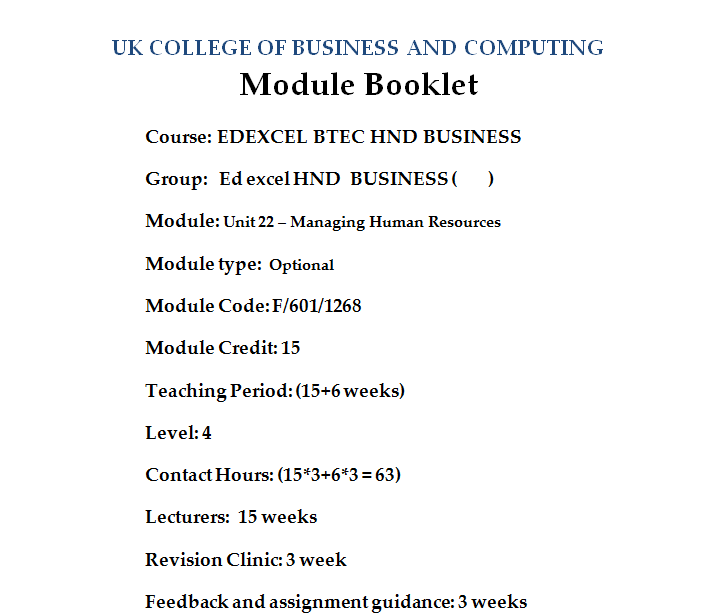Unit 22 Managing Human Resources Assignment Brief

INTRODUCTION
This unit sets the scene by looking at the different theoretical perspectives of human resource management and exploring the differences in these approaches. A variety of changes in the labour market, and the increasing demand from employees for a more manageable work-life balance, has seen the development of much more flexible working practices. This has been the case in all sectors of the economy and in all organisations irrespective of their size or the nature of their business. Some workers have a statutory right to flexible hours and all workers can ask their employer to accommodate their needs in terms of a more flexible pattern of working. This unit examines a variety of flexible working models and looks at practical methods that have evolved in many organisations to meet the needs of employers and employees. Some elements of the unit require an awareness of the legislative framework which determines the nature and scope of human resources policies and practices. However, the unit does not require detailed knowledge of health and safety or equal opportunities legislation. It examines the practical impact of this legislation on human resources policies and practices. New approaches are explored, including the implications for human resources management of the shift from equal opportunities to managing diversity in the workplace. The unit explores the different methods of performance management. It examines issues that may affect performance at work, such as ill health and absenteeism and will develop learner understanding of counselling and human resources practices that support employee welfare in the workplace.
Aim:
The aim of this unit is to develop an understanding of the theory and practice of human resource management focussing on current human resources practice and the impact of topical issues and legislation. This unit sets the scene by looking at the different theoretical perspective of human resource management and exploring the differences in these approaches. A variety of changes in the labour market, and the increasing demand from employees for a more manageable work-life balance, has seen the development of much more flexible working practices. This has been the case in all sectors of the economy and in all organizations irrespective of their size or the nature of their business. Some workers have a statutory right to flexible hours and all workers can ask their employer to accommodate their needs in terms of a more flexible pattern of working. This unit examines a variety of flexible working models and looks at practical methods that have evolved in many organizations to meet the needs of employers and employees.
Key Objectives:
- Understand the different perspectives of human resource management
- Understand ways of developing flexibility within the workplace
- Understand the impact of equal opportunities in the workplace
- Understand approaches to human resources practices in organisations.
- Answer the question, “What is human resource management?”
- Discuss the components of the changing environment of human resource management.
- Describe the nature of strategic planning.
- Give examples of human resource management’s role as a strategic partner
Learning Outcomes and assessment criteria:
LO1 Understand the different perspectives of human resource management
1.1 explain Guest’s model of HRM
1.2 compares the differences between Storey’s definitions of HRM, personnel and IR practices
1.3 assess the implications for line managers and employees of developing a strategic approach to HRM
LO2 Understand ways of developing flexibility within the workplace
2.1 explain how a model of flexibility might be applied in practice
2.2 discuss the types of flexibility which may be developed by an organisation
2.3 assess the use of flexible working practices from both the employee and the employer perspective
2.4 discuss the impact that changes in the labour market have had on flexible working practices
LO3 Understand the impact of equal opportunities within the workplace
3.1 explain the forms of discrimination that can take place in the workplace
3.2 discuss the practical implications of equal opportunities legislation for an organisation
3.2 compare the approaches to managing equal opportunities and managing diversity
LO4 Understand approaches to human resources practices in organisations
4.1 compare different methods of performance management
4.2 assess the approaches to the practice of managing employee welfare in a selected organisation
4.3 discuss the implications of health and safety legislation on human resources practices
4.4 evaluate the impact of one topical issue on human resources practices.
Knowledge and Understanding:
- What will 21st century corporations challenges be
- What people related problems are likely to arise as a result of changes in the forms of organizations and how we can avoid these problems
- Is there evidence that high performance work policies are associated with improved financial performance
- What can I do to reverse the perception among many managers that the growing diversity of the workplace is a problem
- How can workforce planning be integrated most effectively with general business help planning
- Why should firms expect to expand their training outlays and their menu of choices for employees at all levels
- How can we best fit our approach to performance management with the strategic direction of our department and business
Indicative content:
- The different perspectives of human resource management
- Flexible working models
- Types of flexibility
- Labour market
- Discrimination inemployment
- Equal opportunities in employment
- Performance management
- Counselling and employee welfare
- Health and safety
Details
Other Assignments
Related Solutions